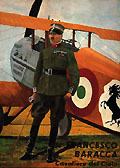 "The
story of the prancing horse is simple and
fascinating. The horse was "The
story of the prancing horse is simple and
fascinating. The horse was
painted on the fuselage of the fighter plane
flown by Francesco Baracca, a heroic Italian
pilot who died on Mount Montello: the Italian ace
of aces of the First World War.In 1923, when I
won the first Savio circuit, which was run in
Ravenna, I met Count Enrico Baracca, the pilot's
father, and subsequently his mother, Countess
Paolina.
One day she said to me, "Ferrari, why
don't you put my son's prancing horse on your
cars; it would bring you luck." I still have
Baracca's photograph with the dedication by his
parents, in which they entrusted the emblem to
me. The horse was black and has remained so; I
added the canary yellow background because it is
the colour of Modena."
Enzo Ferrari
The Ferrari Stables emblem appeared for the
first time in 1929 on all company publications,
signage and official papers,
but not on the cars, which belonged to Alfa Romeo
and wore the Alfa colours, a green cloverleaf in
a white triangle.
The shield made its debut on the cars on July
9 and 10, 1932, at the Spa 24 Hours. There could
not have been a more auspicious occasion: the
race was won by the car driven by Taruffi and
D'Ippolito, ahead of Siena and Brivio.
After that victory, the shield adorned all the
official Ferrari Stables cars in the Thirties,
right up to the moment the
stables became the official Alfa Corse
department, directed by Enzo Ferrari, but run by
the company.
The first Ferrari to sport the trademark on
its bonnet was a 125 driven by Franco Cortese on
May 11, 1947, the
Maranello company's racing debut, on the Piacenza
circuit. Designed by the Ferrari Technical
department and produced
by the Castelli e Gerosa company of Milan and
Cristiglio of Bologna, it remained unchanged
until 1950.
In 1952, Enzo Ferrari decided to bring back
the racing badge of the old Ferrari Stables,
modernised and stylised, to
distinguish the official cars from those of the
many customers who tried their hands at racing
their own cars,.
It made its debut on March 16 on the cars
competing in the Siracusa Grand Prix, the 500
F2's driven by Ascari,
Taruffi, Farina and Villoresi. This was another
triumph, with Ascari, Taruffi and Farina taking
the first three places in
that order. That same year, Ascari won the
Drivers World Championship, the first of
Ferrari's 25 championship titles,
in a 500 F2.
Since then the symbol has been scrupulously
applied, with occasional exceptions, in its
conventional form which has never changed, on all
Ferrari cars of any category entered in races by
the "competitor Ferrari".
The horse first appeared on the radiator
grille in 1959. Produced by the Turin company
Cerrato for the cars with body by Pininfarina,
and etched by Incerti for Scaglietti cars, it was
cut out of 3 mm thick sheets of brass
pantographed and chrome-plated. It remained the
same until 1962, and there was also a special
version, serrated and bored by hand, that was
used on a few exclusive cars and on cars destined
for exhibitions and fairs. Between 1962 and 1963
the horse was
produced in relief but it was not a success, and
was only used for a year, being judged
stylistically and proportionally
unsuitable. A subsequent version was developed,
with a flat horse pantographed on aluminium and
then mirror polished;
it was introduced in 1964, adopted until the BB
model, and then recovered in 1984
for the Mondial, 328 GTB and GTS,
while an identical, anodised version in black
adorned the first Testarossa and 348.
A new relief version of the horse was proposed
in 1963, but this too met with little enthusiasm.
It was considered
superfluous because the flat version was now
applied regularly on the radiator grille.
However, its development went
ahead, so that it could be used if necessary on
the rear of the car, as it was on the Mondial in
1988-89. And that was
how the ornamental horse, destined to become an
extremely familiar sight, came to be created,
almost unwanted.
It was to remain substantially the same for over
30 years, adorning the back of nearly all Ferrari
models, with only small variations to the colour
and size. In 1982 it also appeared on the front
of the cars, replacing the flat pantographed
version.
Since 1992 it has featured on the entire Ferrari
range, with well- defined forms for use on the
front and rear.
From 1953 to 1961 a trademark combining the
initials of the Ferrari and Farina names in the
naval alphabet,
was used on cars designed by Pininfarina. The red
rhomboid against a white background which
indicated the
letter F, was replaced by the letter P (white
rectangle in blue field) when the designer
changed his surname to
Pininfarina. This trademark was generally
abandoned in 1964, except for 2+2 models; and
currently appears on
the front tunnel of the 456 GT.
Today's Ferrari trademark - Baracca's black
horse against a canary yellow background - in the
versions used for industrial production and
technical and racing activities, are all
registered, and are used on every graphical
production of the
company, for projects and drawings, Ferraridea
promotional items, badges and decals, service and
maintenance
signage, official documents and for recognised
Ferrari Clubs.
|
![[The most important feature on your car is not an option.]](/images/sponsors/allstate/scale.gif)
![[The most important feature on your car is not an option.]](/images/sponsors/allstate/scale.gif)